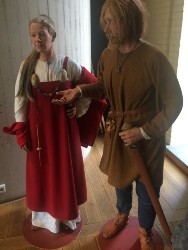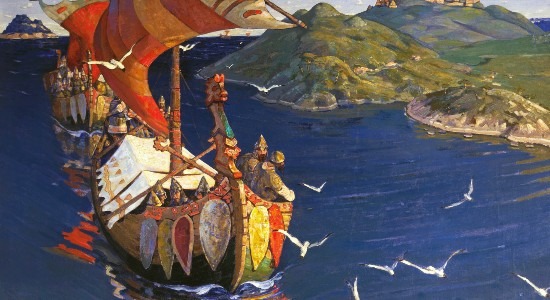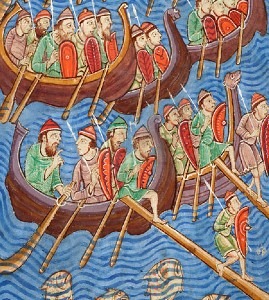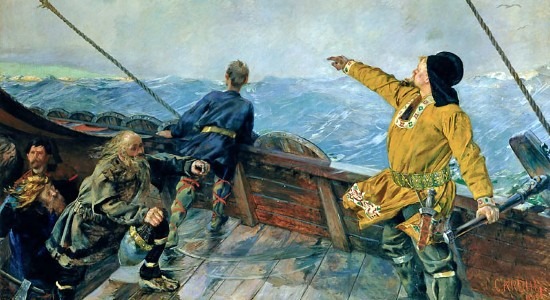MedievalReporter.com
Covering history's most marvelous millennium
Join our newsletter!

Covering history's most marvelous millennium
Covering history's most marvelous millennium
Vikings were Norsemen who raided and traded throughout large parts of Europe. The Norsemen were the Germanic inhabitants of Scandinavia. Those among them that took to the sea were called “viking” – meaning: pirate. As such, the term was more of a job description than an ethnicity. Vikings were renowned for their seafaring skills in their famous longboats.
As their expeditions expanded, some Vikings grew out of their pirate life and settled down. They colonized areas such as Iceland, the British Isles, France, Sicily, Ukraine and North America. Other expeditions reached distant destinations such as Constantinople, Arabia and Persia.
Their far-flung influence has been summarized as the Viking Age, commonly dated from the 8th to the 11th century CE.
This is a short intro from our Medieval Guidebook. Dive deeper into the subject by reading our articles about it.
Vikings came from Scandinavian lands, roughly the same as the modern Nordic countries. Ethnically, they were Norse or Northmen – the North Germanic inhabitants of these regions. Medieval people called them Nortmann (Frankish) or Norðmannum (Old English). Others labeled the entire group as “Danes” or simply “heathens”. When medieval contemporaries referred to them as “wicings” or “vikings”, they specifically meant their life of raiding and pirating – not their ethnic origins.

Sagas conserved and expanded the core of Norse literary culture. Great stories were told and retold about the gods and heroes of old. The Norse were not afraid of dying in battle, believing an honorable death on the battlefield meant joining the gods in Valhalla. These stories significantly influenced English culture especially. Tuesday, Wednesday, Thursday and Friday all refer to Viking deities (Týr, Woden, Thor and Freya).
Other important aspects of Norse culture were feasts, games (like chess) and sports (like wrestling and mountain climbing). Ships, however, formed the most integral part of Northern culture. Not only were they useful for transportation, exploration or trade. Ships also held a religious function: some rich Northmen were buried with them. Over time, the popular longship has become nearly synonymous with their culture.
Ultimately, their shipbuilding and seafaring skills allowed the Norsemen to “go viking”: a pirate’s life.

During the Early Middle Ages, the Norsemen excelled as explorers and seafarers. Improvements to their techniques, like sailing and 24-hour rowing by multiple crews, allowed them to travel even farther. The reasons why they started attacking coastlines across Europe were manifold.
Because of their seaborne travels to these lands, the Norsemen knew exceptionally well the amount of treasure to be had overseas. They had built up a thorough knowledge of the riches ripe for plunder in England, Francia and other regions. Simultaneously, there was a shortage of women because of selective female infanticide – the Northmen preferred sons. Additionally, men were allowed multiple women but not vice versa, further destabilizing the ‘sexual economy’. To make matters worse, kings and dynasties emerged who centralized power and drove smaller-scale chieftains from their lands.
Taken together, there was a myriad of factors pushing a sizable selection of jobless, single yet ambitious men away from Scandinavia and out into the sea. So they “went viking”: their plunder would increase both their economic and marriage prospects. In the early 8th century CE, Estonia was among the first to bear the brunt of Viking raiding. England followed suit: Vikings raided and desecrated Lindisfarne monastery in 793. This sent ripples of astonishment and fear across christian Europe.
The Viking Age had begun.

– advertisement –
– article continues below –
The Lindisfarne raid provided the most addictive aspect for future Viking expeditions: success. Returning home laden with plunder, Vikings inspired even more Northmen to join them. Before long, they not only harried the British Isles but attacked the wavering Frankish Empire as well. Northmen even established a duchy on Frankish territory, aptly named “Normandy”. Others went even further south and overthrew the Emirate of Sicily.
As long as impressive fortifications such as the Danevirke shielded Scandinavia, the Vikings could spend many months overseas without fear of enemy retaliation overland. Consequently, they also ranged far and wide to the east, steering their longships up the Neva and Dnieper rivers. In these basins, they established the first Rus’ states. Some Vikings continued even farther, where they reached Constantinople and served in Byzantine armies. Other groups raided the Caspian Sea, assisted the Georgian king and attacked Persian lands.
To the west, Viking expeditions focused more on settling and colonizing. They took control of Iceland. Then they discovered an even icier island, which they called “Greenland” to attract more settlers. Ultimately, Vikings beat Columbus by some 500 years in discovering North America. They tried to colonize the shore of Newfoundland but were driven back into the sea by indigenous peoples who were hostile to them.

Disclosure: we work hard to provide you with exclusive medieval reports and guides. To make the Middle Ages accessible to everybody, we’d like this information to remain FREE. Therefore, some of the links below are affiliate links, meaning – at no additional cost to you – we will earn a small compensation if you click through.
Grab a short intro on another civilization from our Medieval Guidebook.